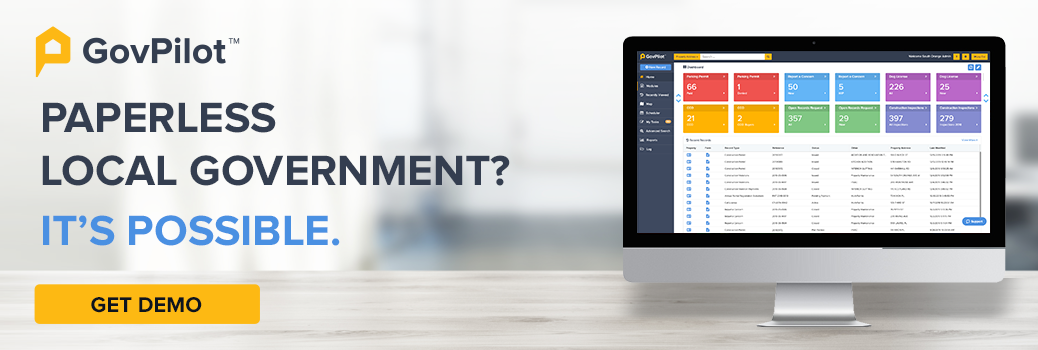It is clear that post-pandemic, work culture and the recruitment process in the United States will certainly never be the same. For many localities and public-sector employers, the process of finding high-quality, talented candidates has been challenging at a time when governments need to hire as the economy rebounds and the world re-opens but find themselves competing with private businesses for top talent. Why is recruiting for local governments more difficult than ever? And how can your municipality or county government overcome these challenges?
Government leadership should reconsider public sector recruiting and how innovation and modern technology can make the workplace more efficient, while making public service careers a more desirable option among young and middle-aged workers. Follow along for some tips on public sector staffing and how technology can improve your government efficiency, productivity, and responsiveness.
Why is Public Sector Recruiting More Difficult Than Ever?
Government staffers are not the only ones having a tough time finding qualified candidates. Industries across the country are facing hiring challenges like never before. But why?
Even before the pandemic, city and county governments were feeling a staffing squeeze as baby boomers retired in droves. Now, the tight job market is making it harder to attract millennials to government jobs as many of them are more interested in higher-paying, "sexier" opportunities in the private sector.
In 2018, 44% of state and local employers said that retirements are on the rise, with some workers even accelerating retirement dates, according to the most recent workforce report by the Center for State & Local Government Excellence. According to the Economic Policy Institute, state and local government employees made 3.7% to 8.2% less than their counterparts in the private sector in 2018. So it is no surprise that local governments are becoming short-staffed all while it is increasingly difficult to recruit new, qualified candidates to the public workforce.
In other cases, people began to prefer a work from home lifestyle. Be it a fear of COVID, a desire to spend more time with family, avoid a lengthy commute, millions of Americans experienced remote working for the first time, and now prefer not to go back to an office environment. That means if your municipality doesn’t offer remote work opportunities - or at least have those capabilities in the even of a crisis such as a flood - the recruitment process will be all the more difficult.
Another significant recruiting challenge for municipalities is competition from the private sector. Tech-savvy start-ups and businesses are all the rage for younger entry-level workers and beyond, making local governments with less advanced technology and processes not as appealing for many potential applicants.
All of these reasons are worth considering as you reflect on human resource planning for your municipal government, especially as we delve into how you can overcome these challenges.
How to Recruit and Select High Quality Talent for Your Local Government?
Despite the newest challenges in public sector recruitment, your local government can still hire great talent.
The top two reasons people apply for state and local government roles are job security (61%) and benefits packages (58%) across all age groups, per the survey.
Millennials also ranked career advancement and professional training high on the list of things that would attract them to apply for jobs.
Here are some of the ways you can improve your odds of finding a good government employee:
-
Update your IT infrastructure: Let's be honest, the average person equates the local government sector with archaic, slow business practices and processes - like paper filing, and antiquated, inefficient computer programs. Most job seekers (especially younger and entry-level workers) are looking to work in innovative environments with the latest technology. How many 20 - 30 year olds want to fill and file paperwork... let alone know how to? Unfortunately, many small governments are not up to speed technologically. This makes them inefficient and slow to respond to constituents. Consider upgrading to modern government management software that will not only appeal to tech-savvy younger workers but will also make your municipality more productive even with fewer workers.
-
Offer remote / hybrid work opportunities: After the pandemic, many people would appreciate the flexibility to work remotely full time or in a hybrid arrangement where a few days are spent at home and a few in the office. If your local government leverages cloud-based software instead of on-site servers, you can give municipal workers the flexibility to work from home when necessary, which as North Bergen, NJ learned can actually ensure business continuity in the event of a crisis.
-
Update your “brand”: in many cases, the government is losing skilled workers to more sophisticated, interesting, higher paying private businesses. As a result, your local government should consider ways to make it appear like a well-branded business to potential applicants. That means you should consider your public perception (brand recognition) and work towards having a meaningful brand promise that outlines your communal objectives and demonstrates contemporary thinking. This could include updating your government’s website to give it a modern look and user experience, or enabling constituents to report concerns via a mobile app.
-
Keep an open mind: Any good recruitment strategy should include the notion that there is no such thing as a perfect candidate. In fact prospective candidates, particularly young people who might be interested in a career in public sector organizations will likely bring a diversity of experience and expertise that make them attractive to government employers. Consider skill sets like social media, coding, online browser research, computer competency, and writing. Innovative, responsive government will require workers with technological savvy. It's time to make local government an attractive career path for Gen-Z and Millennials.
-
Incentivize younger talent with training, mentorship, and pensions: Fellowship programs can be useful for attracting diverse candidates, hiring recent grads or mid-career private sector employees, says Hollie Russon Gilman, fellow with New America's Political Reform Program.
Debt forgiveness programs could lure millennials saddled with student debt.
"People want opportunities for advanced learning, mentorship and clear pathways to leadership — but you don't necessarily see enough of that in the public sector," Gilman said. "The key is building leaders who don't think of themselves as leaders."
Young staff can also reverse mentor their senior-level colleagues on important subjects such as communicating via social media, digital process and software implementation, and cybersecurity best practices. -
Purpose as a perk: While salary is often a driving factor in where people decide to work, it has been noted that the Millennial and the younger Gen-Z generations are driven by purpose. They want to make a positive impact on their communities, and the planet they live on. Public sector entities should highlight the opportunity to make a meaningful difference in the lives of fellow citizens through public service, noting a desire to inject the ideas and expertise of younger generations into local government administration.
How Can Technology Help Your Local Government to Get Work Done?
The honest truth is that local governments had a tough time recruiting even before the pandemic. From 2018 to 2019, the average hiring rate was down 5.4% compared to a similar time frame from 2014 to 2015. Many experts attribute this decline to rising private sector salaries that outmatch public sector salaries in most cases.
That means even your best effort to recruit top candidates at all levels, and to update your government's "brand voice" may not result in all of your open roles being filled.
Fortunately enough, digital technology can fill the void created by job openings across governmental departments. With digital forms, and workflow automation provided by government management software like GovPilot, fewer employees can get more work done, which means you can keep your government lean and your workforce more efficient than ever. For example, a Clerk Department that was once staffed by five clerks prior to GovPilot, could get even more work accomplished with just three clerks using GovPilot, enabling the government to reassign the two remaining clerks to other departments in need of staff.
Here are some examples of ways that government management software can help your municipality get work done:
-
Digitized permit and license filing: helping businesses and individuals file permits and licenses is a staple of the clerk's department. If you can’t get administrative roles filled, constituents and business owners will be aggravated as they await your government’s approval. In one GovPilot case study, the clerk's department said they saved 40 hours a month by switching to digitized forms that constituents can fill out online. Workflow automation provided by GovPilot means staff spend less time spent on manual tasks, and are able to provide quicker turnaround times for your constituents. Less repetitive, manual tasks like data entry, and filing, and fewer distractions like constituent phone calls and walk-ins translates into more meaningful, impactful work for your employees.
-
Expedited building inspections: in the past, inspecting buildings was often a daunting and time consuming process conducted using paper and a clipboard. Now, with the GovInspect App, building and health inspections are seamless and can be completed on a mobile tablet such as an iPad or Surface, meaning building inspectors can complete far more assessments every week than they could have with paper and a clipboard. No more traveling back to the office to manually enter into a spreadsheet the information written down on site.
-
Innovative workflows in the courthouse: operating your local courthouse has always required a lot of manpower to hold hearings and file paperwork. Virtual court hearings and digitized forms for appealing court decisions or requesting records via OPRA or FOIA can save time and will require far fewer man hours.
-
Save time in your recruiting processes: Ironically, government management software can expedite many of the day to day tasks of your human resources department, meaning you can save hours of time for your recruiters and HR staff members. Things like job posts, employment applications, and evaluation processes can all be done from the cloud, making it easier to find new talent with less labor and time spent on the back end.
In Conclusion
You’re not alone in the struggle to find high-quality talent. With a tight labor market and competition from the private sector, local governments across the country are struggling to hire new employees. Fortunately, your municipality can take steps to make government work a more attractive career option and improve your human resource management. Leveraging government management software is a key component in modernizing public agencies, and local governments which in turn will make them more efficient, effective, and a desirable place to work for those seeking to serve.
To learn more about how to implement government management software across departments, schedule a free consultation.
Public Sector Recruiting FAQ
1. Why has it been difficult for local governments to recruit employees?
Government, particularly local government - fairly or unfairly - has a reputation as being slow, inefficient, and resistant to technology. Tech-savvy start-ups and businesses are all the rage for younger entry-level workers and beyond, making local governments with less advanced technology and processes not as appealing for many potential applicants. Furthermore, high salaries in the private sector are more attractive to many qualified candidates.
2. Why is it important for local governments to hire younger employees?
Even before the pandemic, city and county governments were feeling a staffing squeeze as baby boomers retired in droves. Now, the tight job market is making it harder to attract millennials to government jobs as many of them are more interested in higher-paying, "sexier" opportunities in the private sector. Younger workers are needed in local government to replace retiring staff and to bring a level of digital expertise that is needed for modern local governments to provide convenient constituent services and operate efficiently.










